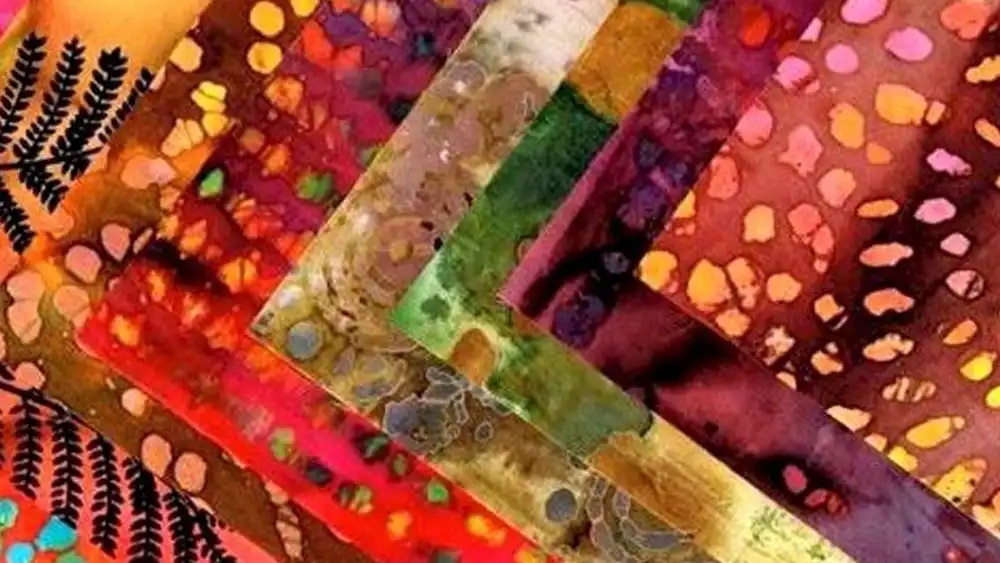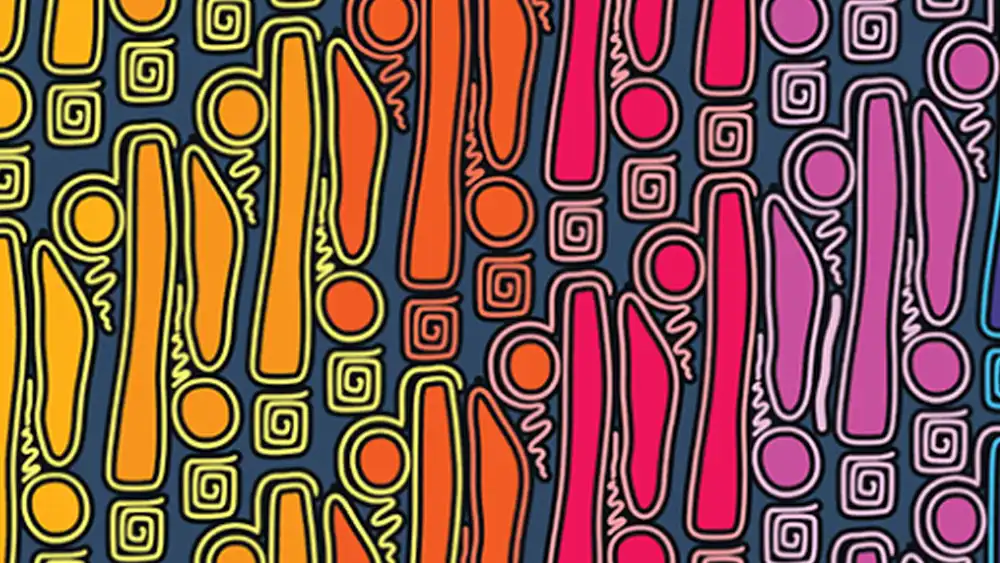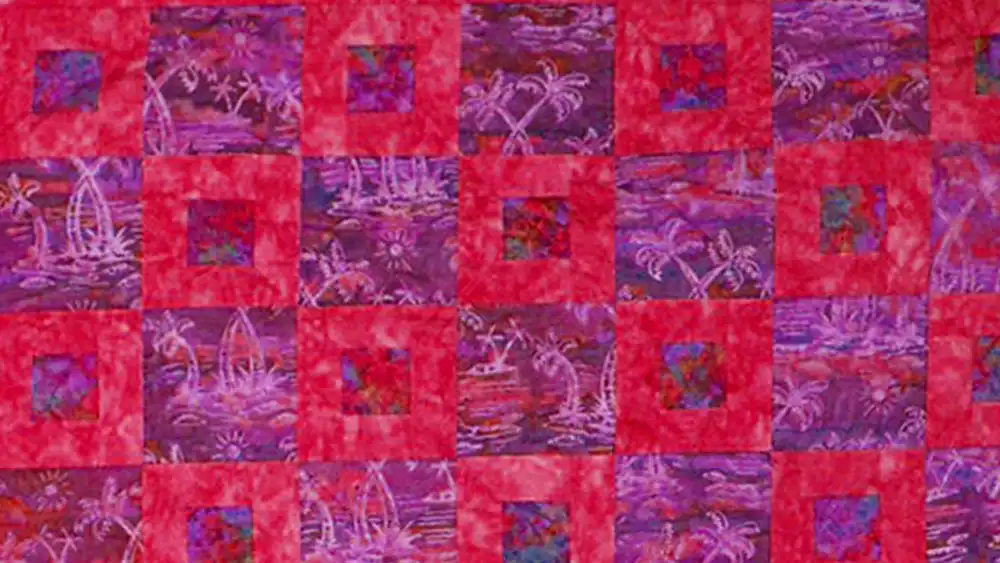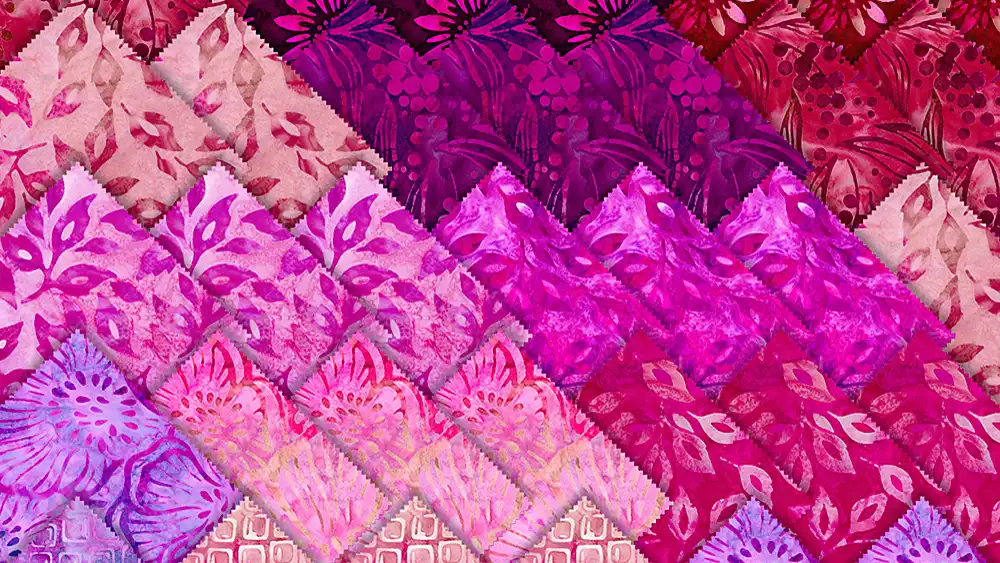Batik quilting fabric stands out in the world of textiles for its unique creation process and stunning visual appeal. Unlike conventionally printed fabrics, batiks are handcrafted using a wax-resist dyeing method, resulting in distinctive patterns and vibrant, saturated colors that penetrate both sides of the cloth.
This guide will delve into what makes batik fabrics so special for quilters. We’ll explore their origins, the intricate process of their creation, and why their tight weave and rich hues make them a cherished choice for adding depth and artistry to your quilting projects.
What Is Batik Quilting Fabric?

Batik quilting fabric is a type of fabric that combines the traditional art of batik with the practicality of quilting.
It features intricate designs and vibrant colors that are created using a wax-resist dyeing technique. In batik quilting, hot wax is applied to the fabric in specific patterns using a tool called a tjanting or a stamp. The wax acts as a resist, preventing the dye from penetrating certain areas of the fabric.
After the wax is applied, the fabric is submerged in dye, allowing the colors to seep into the untreated areas. This process can be repeated multiple times to achieve intricate designs and vibrant hues.
Origin of Batik Quilting Fabric

Batik is an ancient art form with a rich history, primarily originating from Indonesia, particularly the island of Java. Its roots trace back over 2000 years, making it one of the oldest textile traditions globally. The word “batik” is believed to be derived from the Javanese word “ambatik,” meaning “a cloth with little dots,” referring to the intricate patterns created by the wax-resist dyeing method.
While Indonesia is the most renowned for its sophisticated batik traditions, evidence of similar wax-resist dyeing techniques has also been found in ancient Egypt, India, China, and parts of Africa, suggesting independent development or early cultural exchanges.
Over centuries, particularly in Indonesian royal courts, batik evolved from a means of spiritual expression to a highly esteemed art form, with each motif often carrying symbolic meaning and reflecting regional identity.
Types of Batik Fabric

Batik fabric encompasses a fascinating range of styles, each with its own regional characteristics and artistic techniques. While the core wax-resist dyeing method remains, variations in application and cultural influences lead to diverse outcomes.
Batik fabric’s unique qualities make it highly versatile, finding its way into a myriad of creative projects beyond traditional garments. Its tight weave, vibrant colors, and distinctive patterns lend themselves well to a wide array of applications.
Types of Batik Fabric
- Hand-Drawn Batik (Batik Tulis): This is the most traditional and labor-intensive method, where wax is applied by hand using a “canting” (a pen-like tool). This results in fine, intricate lines and unique, often irregular patterns, making each piece a singular work of art. The precision and artistry involved make these highly prized.
- Stamped Batik (Batik Cap): In this method, copper or wooden stamps (“cap”) are dipped in wax and then pressed onto the fabric. This allows for more repetitive and consistent patterns, making the production process faster and more economical than hand-drawn batik, while still retaining a handcrafted feel.
- Combination Batik: Many batiks combine both hand-drawn and stamped techniques. Larger areas or repeating motifs might be stamped, while intricate details or unique elements are added by hand with a canting, offering a balance of efficiency and artistic detail in the final fabric.
Uses of Batik Fabric
- Home Decor: The rich colors and artistic patterns of batik fabrics make them perfect for enhancing home interiors. They are frequently used for decorative items such as cushion covers, table runners, wall hangings, curtains, and even upholstery, bringing a touch of global artistry to any space.
- Quilting: Batik fabrics are exceptionally popular for quilting due to their saturated colors, reversible nature (patterns often penetrate both sides), and tight weave. This makes them ideal for precise cutting and piecing, adding depth, texture, and a unique visual appeal to quilt blocks and finished projects.
- Apparel and Accessories: Historically and currently, batik is widely used for clothing like sarongs, dresses, shirts, and scarves. Its comfortable drape, breathability (especially cotton batiks), and vibrant designs make it suitable for both traditional and contemporary fashion, offering a distinctive look.
Benefits of Batiks

When it comes to quilting, using batik fabrics offers you a myriad of benefits that elevate your projects to a whole new level.
Here’s why incorporating batiks into your quilting endeavors is a fantastic idea:
Vibrant Colors: Batik fabrics are renowned for their intense and vibrant colors. They add a pop of brilliance to your quilts, making them visually stunning and captivating.
Intricate Designs: The intricate patterns and designs found in batik fabrics are unmatched. Each piece tells a unique story, adding depth and character to your quilting projects.
Unique Texture: Batik fabrics have a unique texture that adds dimension to your quilts. The wax-resist dyeing process creates subtle variations in color and texture, giving your quilts a tactile quality that is truly special.
Versatility: Batik fabrics are incredibly versatile and can be used in a variety of quilting projects. Whether you’re making a traditional patchwork quilt or a modern art quilt, batiks add a touch of elegance and sophistication.
Durability: Batik fabrics are known for their durability and longevity. They hold up well to repeated washing and wear, ensuring that your quilts will last for years to come.
Global Appeal: Batik fabrics have a universal appeal that transcends cultural boundaries. They are cherished by quilters and artisans around the world, making them a truly global phenomenon.
Artisanal Craftsmanship: Each piece of batik fabric is handcrafted by skilled artisans using traditional techniques passed down through generations. This craftsmanship imbues batik fabrics with a sense of authenticity and heritage that is truly special.
Incorporating batik fabrics into your quilting projects not only enhances the visual appeal of your creations but also adds a unique and personal touch that sets them apart. So why not add some batiks to your fabric stash and unleash your creativity in your next quilting adventure?
How is Batik Made?

Batik production is a meticulous, multi-step process involving successive applications of wax and dye. This ancient art transforms plain fabric into vibrant, patterned textiles through careful resist-dyeing techniques.
Preparing the Fabric
The process begins with preparing the fabric, typically cotton. It is thoroughly cleaned to remove impurities, starched, or sizing, which could prevent the dye from adhering properly. After washing, the fabric is often stretched and smoothed, ensuring a pristine surface ready for the intricate wax application.
Applying Wax
Next, molten wax is applied to the fabric using either a canting (a pen-like tool for fine lines) or a cap (a copper stamp for repetitive patterns). The wax acts as a resist, preventing the dye from penetrating the areas it covers. This step defines the patterns that will remain undyed in the first color application.
Dyeing
After the wax is applied, the fabric is immersed in a dye bath. The dye penetrates only the areas of the fabric not covered by wax. For multi-colored batiks, this step is repeated: new layers of wax are applied over previously dyed areas or new designs, and the fabric is then dyed in a different color.
Removing Wax
Once all dyeing steps are complete, the wax is removed. Traditionally, this is done by boiling the fabric, which melts the wax away, or by scraping. The removal reveals the intricate patterns where the fabric was protected, exposing the original fabric color or previous dye layers, creating the distinctive batik effect.
Finishing
Finally, the fabric undergoes a finishing process. This typically involves washing to remove any residual wax or dye, and then drying. Sometimes, the fabric is treated to enhance its texture or durability. This final stage prepares the batik fabric for its ultimate use in garments, quilts, or home decor.
How to Wear Batik Quilting Fabric

Wearing batik quilting fabric allows you to showcase its vibrant colors, intricate designs, and unique textures in your attire.
Here’s how you can incorporate batik quilting fabric into your wardrobe with style:
- Batik Dresses: Opt for a batik quilting fabric dress for a chic and vibrant look. Whether it’s a flowy maxi dress for a casual outing or a fitted sheath dress for a more formal occasion, batik fabric adds a touch of elegance and sophistication to your ensemble.
- Batik Tops: Pair a batik quilting fabric top with jeans or trousers for a stylish and effortless look. Choose from a variety of styles, such as blouses, tunics, or button-down shirts, to suit your personal taste and preference.
- Batik Skirts: A batik quilting fabric skirt is a versatile wardrobe staple that can be dressed up or down for any occasion. Pair it with a simple tank top or blouse for a casual daytime look, or dress it up with a tailored blouse and heels for a more formal affair.
- Batik Scarves: Add a pop of color and texture to your outfit with a batik quilting fabric scarf. Whether worn around the neck, draped over the shoulders, or tied around the waist as a belt, a batik scarf adds a stylish finishing touch to any ensemble.
- Batik Accessories: Incorporate batik quilting fabric into your accessories for a unique and personalized look. From handbags and clutches to hair accessories and jewelry, there are endless ways to accessorize with batik fabric and make a statement.
When wearing batik quilting fabric, let the fabric take center stage by keeping the rest of your outfit simple and understated. Opt for solid colors and minimalistic designs to allow the beauty of the batik fabric to shine through. Whether you’re dressing up for a special occasion or simply adding a touch of flair to your everyday look, wearing batik quilting fabric is sure to turn heads and make a statement wherever you go.
Tips for Sewing With Batiks

Sewing with batik quilting fabric can be a rewarding experience, but it does require some special considerations due to the unique characteristics of the fabric.
Here are some tips to help you sew with batiks like a pro:
Use Sharp Needles: Batik fabrics tend to be tightly woven, so it’s important to use sharp needles to ensure smooth and precise stitching. Opt for a universal or microtex needle in a size appropriate for the weight of your fabric.
Pre-Wash Your Fabric: While batik fabrics are often colorfast, it’s still a good idea to pre-wash them before sewing to remove any excess dye and minimize the risk of color bleeding. Use a gentle detergent and cold water, and avoid using fabric softeners, which can affect the fabric’s texture.
Stabilize Your Fabric: Batik fabrics can be slightly stretchy due to the dyeing process, so it’s helpful to stabilize them before sewing to prevent distortion. Consider using a lightweight stabilizer or interfacing on the wrong side of the fabric to add stability and support.
Use a Walking Foot: A walking foot or even-feed foot can help prevent uneven feeding of the fabric layers during sewing, especially when working with multiple layers or thick seams. This can result in more accurate stitching and smoother seam allowances.
Adjust Tension Settings: Batik fabrics may require adjustments to your sewing machine’s tension settings to achieve optimal stitch quality. Experiment with different tension settings on scrap fabric before starting your project to find the perfect balance.
Take Your Time: Sewing with batik fabrics requires patience and precision. Take your time when cutting and sewing to ensure accurate seam allowances and clean, professional-looking results.
Press Carefully: Use a dry iron set to the appropriate temperature for your fabric to press seams and shapes without steam. Avoid dragging the iron across the fabric to prevent distortion, and use a pressing cloth if necessary to protect delicate batik designs.
Consider Quilting Techniques: Batik fabrics are ideal for quilting projects due to their vibrant colors and unique textures. Experiment with different quilting techniques, such as free-motion quilting or hand quilting, to enhance the beauty of your batik quilt.
By following these tips and techniques, you can enjoy a smooth and successful sewing experience with batik quilting fabric, allowing you to create beautiful and long-lasting projects with ease.
When to Use Batiks?
Knowing when to use batik quilting fabric can help enhance your quilting projects and bring out the best in your designs.
Here are some scenarios where batiks shine:
Bold and Vibrant Designs: Batik fabrics are renowned for their intense colors and intricate patterns. When you want to make a statement with your quilts and projects, batiks are the perfect choice. Their bold colors and eye-catching designs add depth and drama to your creations.
Complex Patterns and Designs: Batik fabrics excel in projects that feature intricate patterns and designs. The wax-resist dyeing technique used in batik production allows for precise and detailed motifs, making them ideal for quilts with complex piecing or appliqué work.
Artistic and Contemporary Quilts: If you’re drawn to modern and artistic quilting styles, batik fabrics are a natural fit. Their vibrant colors and unique textures lend themselves well to contemporary designs, adding visual interest and depth to your quilts.
Cultural and Ethnic Themes: Batik fabrics have a rich cultural heritage and are often associated with traditional and ethnic motifs. When creating quilts with cultural or ethnic themes, batiks can help convey authenticity and evoke a sense of tradition and heritage.
Texture and Dimension: The wax-resist dyeing process used in batik production creates subtle variations in color and texture, giving batik fabrics a unique and tactile quality. When you want to add texture and dimension to your quilts, batiks are an excellent choice.
Quilts with Global Inspiration: Batik fabrics have a universal appeal that transcends cultural boundaries. Whether you’re inspired by the colors of the tropics, the patterns of Africa, or the motifs of Asia, batiks can help bring your global-inspired quilts to life.
Quilts with Personal Significance: Batik fabrics are often cherished for their handcrafted quality and artistic beauty. When creating quilts with personal significance, such as heirloom quilts or commemorative quilts, using batiks can add a special touch of craftsmanship and authenticity.
Batik Quilting Fabric Maintenance

Maintaining batik quilting fabric is essential to preserve its vibrant colors, intricate designs, and unique textures for years to come.
Here are some tips for caring for your batik quilting fabric:
Gentle Washing: When washing batik quilting fabric, use a gentle detergent and cold water to help preserve the colors and prevent fading. Avoid using bleach or harsh chemicals, as they can damage the fabric.
Hand Washing: For delicate batik fabrics or quilts with intricate designs, hand washing is often the best option. Gently agitate the fabric in a basin of cold water with mild detergent, then rinse thoroughly until the water runs clear.
Machine Washing: If machine washing is necessary, use a gentle cycle with cold water and a mild detergent. To protect the fabric, place it in a mesh laundry bag or pillowcase before washing. Avoid overloading the washing machine, as this can cause the fabric to become tangled and damaged.
Avoid Excessive Agitation: Batik quilting fabric is delicate and can be prone to fraying or stretching if agitated too vigorously. When washing, avoid wringing or twisting the fabric, as this can distort the designs and weaken the fibers.
Air Drying: After washing, air dry batik quilting fabric by laying it flat on a clean towel or drying rack. Avoid hanging batik fabric to dry, as this can cause stretching and distortion. Keep the fabric out of direct sunlight, as prolonged exposure to sunlight can fade the colors over time.
Ironing: If ironing is necessary, use a dry iron set to the appropriate temperature for the fabric. Avoid using steam, as this can cause water spots and damage the designs. Place a pressing cloth or lightweight fabric over the batik fabric to protect it from direct heat.
Storage: Store batik quilting fabric in a cool, dry place away from direct sunlight and moisture. Avoid folding or stacking heavy items on top of the fabric, as this can cause creases and wrinkles. Consider storing batik quilts in acid-free tissue paper or fabric bags to protect them from dust and damage.
Conclusion
Batik quilting fabric truly offers a unique dimension to your creative projects. Its handcrafted nature, vibrant colors, and tight weave make it an exceptional choice for adding depth and artistry, standing apart from mass-produced prints.
Understanding the intricate wax-resist dyeing process illuminates why batik provides such rich, reversible patterns and durable quality. This ultimate guide equips you with the knowledge to appreciate and utilize this exquisite textile.
For your next stunning quilt or fabric project, consider sourcing wholesale batik fabric from us, ensuring you receive authentic, high-quality materials to bring your artistic visions to life.
